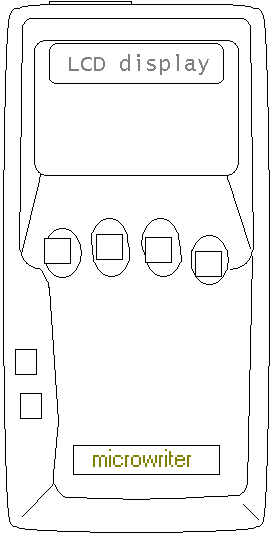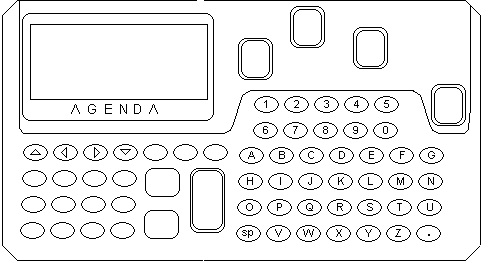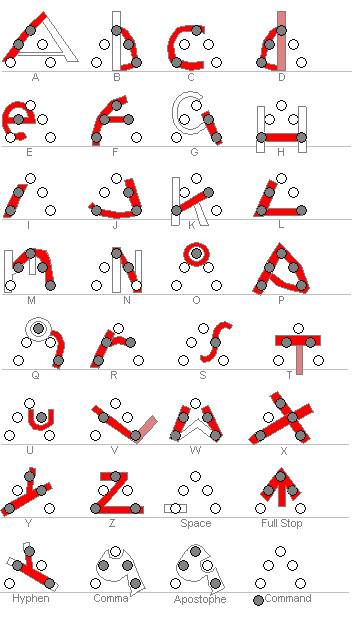Microwriter
The Microwriter chord-keyboard was invented by Cy Endfield and developed by him and Chris Rainey in the 1970s. 
Microwriter's layout and keypresses are the most successful example of the chord technique - there are thought to be about 25,000 users of it and the products that succeeded it. The CyKey - a tiny PC and PDA keyboard is still available.
The Microwriter was available in mid 1980s priced at about £250 - which was expensive for a simple computer, but cheap for a professional word processing system. It provided a complete text editing system and terminal using the novel keyboard. Inside was a battery-powered microprocessor recognising the keypresses and turning them into the computer lingua-franca ASCII code. Text was displayed on a single line LCD display, and could be displayed on a TV using a computer-game style of adapter. Printing and computer terminal work could be done via an RS232 port.
When the Acorn BBC-B computer became very successful in the UK a Microwriter was produced that could act as a keyboard. (It plugged into the analogue port, because the computer had a built in keyboard). Recently the CyKey design has provided a connection to a PC. The lack of a viable PC connection was always a problem for early Microwriter enthusiasts.
The Microwriter was followed in 1989 by the AgendA - a small but full-featured computer with its own programming language and a suite of personal organiser software. Microwriter techniques should be a good match for a small computer intended for strictly personal use.
AgendA was priced at £199. The AgendA had a 4 line LCD screen, personal organiser software and a programming language. It could print to parallel and serial printers, or download data via RS232. The Agenda has the Microwriter keys but also incorporates a small but unconventional alpha keyboard. About 20,000 Agenda's were sold and a bit of research on the web shows some are still in regular use - not many designs last for 15 years.
One problem was that the AgendA seemed a bit expensive for a small computer. The Psion Organiser had a less interesting specification but it was also cheaper, smaller, more conventional and more successful in terms of sales.

Chris Rainey of Bellaire Electronics now makes the CyKey, a successor to the Microwriter.

The CyKey is just a keyboard but it uses IrDA so it is fairly general purpose and can work with either a PC via an IrDA adapter - or natively with Palm PDAs.
Physically the CyKey is a small device with 9 keys arranged in a symmetrical pattern so it can be used left or right handed. The key arrangement has been refined, with the thumb key placed below two shift keys, and two possible keys on the opposite side so that people with small hands can more comfortably use the little-finger key.
The CyKey unit itself costs just under £60, and with the PC IrDA adapter it is just under £80. This makes it one of the least expensive specialist keyboards.
--
Keypresses
The Microwriter keypresses are fairly easy to learn - a couple of days intermittent practice is sufficient to get most of them memorised. Many people probably would need more practice to match their ordinary QWERTY keyboard skills - but then most computer users have been picking letters out on these for years. A lot of development effort clearly went into devising a set of memorable keypresses.

Microwriter keypresses imagine the fingers of the hand forming a rough "A" shape. Letters are then formed in the mind by imagining a particular stroke from the letter. With a bit of practice it becomes easy to form the shape with the fingers. A few letters are not quite straight-forward but they have memory aids - for instance S is signet finger and U is "Very U" - the original card had a picture of a tea cup held ever so nicely.
My own experience was that using a Microwriter was no worse for a beginner than early experience with a QWERTY keyboard had been. Some people say it was slow in use. Microwriting was slower than typing at first, the QWERTY keyboard provides a constant visual reminder of which key to press and most non-professional users do look at the keycaps. Practice with the Microwriter definitely did speed things up, but I never got to the point where I could simply press the right keys unthinkingly.
--
Price And Popularity
The Microwriter posed some problems - but these were not caused by the keypresses, but by other factors in the design and the pricing.
The main problem I had was that I couldn't simply switch to Microwriter keyboards. I was still surrounded by PC and terminal keyboards and couldn't just plug the Microwriter in instead.
Microwriter was designed as a complete word-processing system but the small 16k memory held a couple of pieces of correspondence - not a long report. Reading a document through the 1-line 14 character screen wasn't easy - I lost track. To get real word-processing ability a document had to be transferred into a desk-top computer via RS232 - a messy business requiring the transfer to be started at each end. Worst of all, the Microwriter couldn't easily act as a keyboard for desktop computers - so most work was still done using a QWERTY keyboard with Microwriting as a supplementary skill.
The Microwriter was a professional tool - but typists would not abandon their conventional machines. The Microwriter needed enthusiasts to adopt it, but it was priced rather outside the "so what if it doesn't work" budget.
My personal opinion is that pricing has always created an issue for Microwriter products. The original Microwriter was priced as a word-processor. The AgendA looked expensive compared to Psion's products.
The CyKey may be different. The trade price of PC keyboards is between £2 and £20 - the lower cost units are sold with mainstream PCs and the nicer, more expensive ones feature extra keys, coloured keys and wireless links. PDA keyboards typically are more expensive - £60 to £80. The full CyKey kit isn't cheap, but it is unusually flexible in what it can do.
There is a strong argument that extraordinary design can command a higher price. The HandKey Twiddler - a US design one-hand chord-keyboard mouse combination is substantially more expensive. Practiced CyKey users achieve keying rates of 30 to 60 words per minute - equalling or exceeding those achievable using QWERTY. Achieving this on a range of machines including PCs and PDAs might truly be a liberation so it would easily be worth its purchase price. Bellaire is offering a "money back" guarantee, so some of the risk in purchase is removed.
--
There are something like 500 million PCs in use - mostly with QWERTY keyboards and close relatives although Arabic and Asian variants are available. There are even more mobile phones, many with a truly excruciating method for entering text messages.
Microwriter is probably the most successful chord design - but even with 25,000 users it is addressing a tiny fraction of the market. No other keyboard design seems to offer as much potential as the Microwriter, so it is a surprise it has not been more widely adopted.
(This was written in 2007 so it needs updating)
